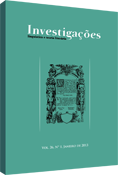O lugar do personagem torturador na construção da vertente testemunhal da contística pós-64 brasileira
Abstract
O presente estudo tem por objetivo analisar o papel do torturador enquanto elemento que ajuda na composição da cena testemunhal presente em alguns contos produzidos durante a vigência do regime militar ditatorial, que vigorou no Brasil a partir da década de 1960. Esta abordagem centra-se no levantamento dos aspectos observados na composição destes personagens que nos permitem classificá-los como complementares na construção de outra personagem, a vítima da violência. Tal análise parte da hipótese de que a confluência entre o contexto histórico (regime de exceção, marcado por uma repressão violenta aos opositores do estado) e a estética narrativa (o realismo cru, a diluição das barreiras entre as formas narrativas, a predominância da narrativa de si) vigente durante este período, possibilitou o surgimento de uma vertente testemunhal na literatura pós-64. Para perceber e compreender em termos formais esta vertente se faz necessária a análise das nuances que a compõe, entre as quais a personificação do estado (através da figura do torturador) e a vitimização do prisioneiro.
Downloads
Published
How to Cite
Issue
Section
License
Copyright (c) 2013 Suellen Monteiro Batista, Tânia Maria Sarmento-Pantoja

This work is licensed under a Creative Commons Attribution 4.0 International License.
Authors who publish with Revista Investigações agree to the following terms:
Authors retain copyright and grant the journal right of first publication with the work simultaneously licensed under the Creative Commons Attribution 4.0 International (CC BY 4.0) license that allows others to share the work with an acknowledgement of the work's authorship and initial publication in this journal.
Authors are able to enter into separate, additional contractual arrangements for the non-exclusive distribution of the journal's published version of the work (e.g., post it to an institutional repository or publish it in a book), with an acknowledgement of its initial publication in this journal.
You are free to:
Share — copy and redistribute the material in any medium or format for any purpose, even commercially.
Adapt — remix, transform, and build upon the material for any purpose, even commercially.
The licensor cannot revoke these freedoms as long as you follow the license terms.
Under the following terms:
Attribution — You must give appropriate credit , provide a link to the license, and indicate if changes were made . You may do so in any reasonable manner, but not in any way that suggests the licensor endorses you or your use.
No additional restrictions — You may not apply legal terms or technological measures that legally restrict others from doing anything the license permits.

